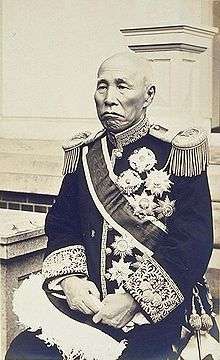Japanese general election, 1902
| | ||||||||||||||||||||||||||||||||||||||
| ||||||||||||||||||||||||||||||||||||||
| ||||||||||||||||||||||||||||||||||||||
| ||||||||||||||||||||||||||||||||||||||
 |
| This article is part of a series on the politics and government of Japan |
|
Related topics |
|
|
General elections were held in Japan on 10 August 1902.[1] The result was a victory for the Rikken Seiyūkai party, which won 191 of the 376 seats.
Electoral system
Electoral reforms in 1900 had abolished the 253 single and two-member constituencies. The 376 members of the House of Representatives were now elected in 51 multi-member constituencies based on prefectures and cities.[2]
Voting remained restricted to men aged over 25 who paid at least 10 yen a year in direct taxation, although 1900 electoral reforms had reduced the figure from 15 yen, increasing the proportion of the population able to vote from 1% to 2%.[2]
Results
| Party | Votes | % | Seats | +/– |
|---|---|---|---|---|
| Rikken Seiyūkai | 433,763 | 50.4 | 191 | New |
| Kensei Hontō | 220,939 | 25.7 | 95 | New |
| Teikokutō | 37,749 | 4.4 | 17 | New |
| Jinin Kai | 35,950 | 4.2 | 28 | New |
| Dōshi Club | 24,541 | 2.9 | 13 | New |
| Others | 107,678 | 12.5 | 32 | – |
| Invalid/blank votes | 8,098 | – | – | – |
| Total | 868,768 | 100 | 376 | +76 |
| Registered voters/turnout | 982,868 | 88.4 | – | – |
| Source: Mackie & Rose, Voice Japan | ||||
References
This article is issued from Wikipedia - version of the 8/24/2016. The text is available under the Creative Commons Attribution/Share Alike but additional terms may apply for the media files.

